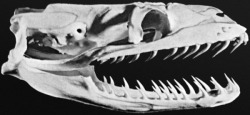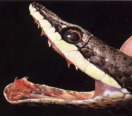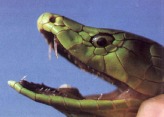
Aglyphous ("lacking grooves") snakes have no specialized teeth - each tooth is more or less the same in shape and often in size. When some teeth are larger than others, as is sometimes the case in bird eaters such as Corralus, the enlarged teeth are merely "scaled up", and are otherwise identical. Aglyphous snakes are non-venomous, and can be found in numerous families.

Opisthoglyphous snakes have fangs at the
back of their mouth (opistho means behind).
These fangs usually have a ‘groove’. When the snake is holding or biting into prey, venom flows down the groove and into the prey’s wound. They are mostly harmless or mildly venomous
to humans.
The only Australian snakes that have grooved fangs are the brown tree snake (Boiga irregularis) and some freshwater snakes in northern Australia.

Proteroglyphous snakes have small fangs fixed in place at the front of their mouth. These snakes’ fangs do not move and are smaller than other types of fangs, so the snake does not puncture its lower lip when it closes its mouth. Fang size ranges from 3 to 10 millimetres long, depending on the size and species of snake.
When these snakes bite they hang on and ‘chew’ into the prey’s flesh to release venom. These are some of the deadliest snakes in the world. Examples of proteroglyphous snakes are cobras, taipans, coral snakes and sea snakes.

Solenoglyphous snakes have hollow fangs that are located at the front of the snake’s mouth. They are hinged, so they can swing forward, stab prey and quickly inject venom before withdrawing their fangs to avoid being injured by the struggling prey.The fangs fold back into a pouch on the roof of the snake’s mouth until they are needed again. These snakes can also open their mouth almost 180 degrees with the fangs extended straight out.Solenglyphous snakes can rotate each fang independently, but when they swing forward
to strike, the fangs are erected together.
When proteroglyphous and solenglyphous snakes lose their fangs, they have five to seven replacement fangs waiting in their gums behind and above the original fang. Depending on the species of snake and how healthy or injured it is, fangs are replaced every ten days to ten weeks.

 RSS Feed
RSS Feed
